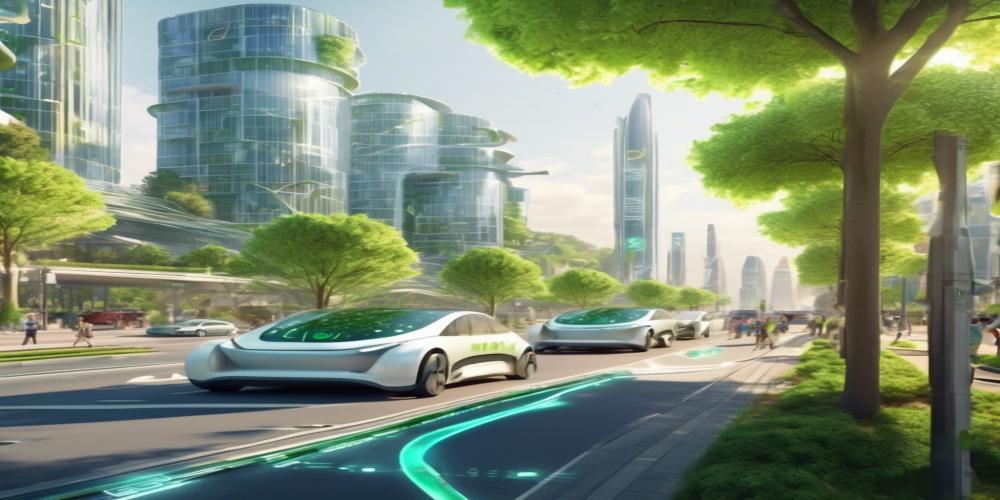The Evolution of AI in Autonomous Cars for a Greener Planet
The concept of autonomous cars has been a part of science fiction for decades, but thanks to rapid advancements in artificial intelligence (AI), what was once a futuristic dream is now becoming a reality. Beyond the promise of making our lives more convenient, autonomous vehicles (AVs) hold immense potential for paving the way towards a greener planet. Here, we explore how AI is driving the evolution of autonomous cars and why this could be a crucial step in tackling environmental challenges.
Introduction to Autonomous Vehicles and AI
Autonomous vehicles are cars that can navigate and operate without human intervention by using a combination of sensors, cameras, machine learning (ML) algorithms, and other AI technologies. These vehicles rely on a complex interplay of software and hardware to interpret data from their surroundings and make real-time decisions. AI is the backbone of this technology, enabling cars to "learn" from vast amounts of driving data and progressively improve their driving capabilities.
Historical Evolution of AI in Autonomous Cars
The journey of AI in autonomous cars dates back to the 1980s when researchers began experimenting with self-driving technologies. Early prototypes developed by institutions like Carnegie Mellon University and companies like Mercedes-Benz demonstrated the feasibility of vehicles that could navigate by themselves. However, it was not until the 2000s that significant progress was made, thanks to the DARPA Grand Challenges which spurred innovation and collaboration among AI researchers and automotive engineers.
Companies like Google (now Waymo), Tesla, and Uber threw considerable resources into developing self-driving cars. By the 2010s, advanced machine learning techniques and deep neural networks made it possible for cars to better understand and interact with their environment. Continuous advancements in AI algorithms have made autonomous cars more reliable, safer, and ready for real-world deployments.
How AI Enables Autonomous Driving
AI in autonomous cars operates through several key components:
- Perception: Using cameras, LiDAR, radar, and ultrasonic sensors, AI interprets real-time data such as identifying obstacles, traffic signs, pedestrians, and other vehicles. Deep learning models process this sensory input to make sense of the surrounding environment.
- Localization and Mapping: High-definition maps and GPS data help the vehicle understand its precise location and plan its path. Simultaneous Localization and Mapping (SLAM) algorithms allow the vehicle to build maps while keeping track of its position within those maps.
- Decision Making: Based on processed sensory inputs and pre-programmed rules, the AI makes driving decisions such as when to brake, accelerate, or change lanes. This requires advanced decision-making algorithms capable of handling complex traffic scenarios.
- Control: After decisions are made, the vehicle's control system executes commands like steering, braking, and acceleration through actuator controls governed by AI.
Environmental Benefits of Autonomous Vehicles
The driving force behind many initiatives to develop autonomous cars is not just about innovation or convenience—there are significant environmental benefits as well. Here’s how AVs could contribute to a greener planet:
- Optimized Driving Efficiency:
AI algorithms can analyze traffic patterns and optimize routes for fuel efficiency. By maintaining optimal speeds and reducing unnecessary stops and starts, AVs can significantly decrease fuel consumption and subsequently reduce greenhouse gas emissions. - Traffic Congestion Reduction:
Autonomous vehicles can communicate with each other through vehicle-to-vehicle (V2V) communication, which allows for smoother traffic flows and reduces traffic jams. Less idling means lower emissions and fuel savings. - Electric Vehicle Integration:
Many autonomous car manufacturers are focusing on integrating AI with electric vehicles (EVs). By making self-driving EVs the norm, we can drastically cut down on fossil fuel dependency while benefiting from the cleaner energy sources used to charge these EVs such as solar, wind, or hydropower. - Shared Mobility Services:
The rise of autonomous ridesharing services could lead to a decline in personal vehicle ownership. Fewer cars on the road means reduced emissions overall. Shared autonomous vehicles would operate continuously throughout the day, maximizing their utility compared to traditional cars which are typically parked for most of their lifecycle. - Improved Parking and Urban Planning:
Since AVs can drop passengers off and find parking spots independently, urban planners could allocate fewer resources to parking infrastructure which consumes valuable land. This opens up spaces for green belts, parks, and urban forests. - Reduced Accident Rates:
Human error contributes to most traffic accidents. Autonomous vehicles promise a significant reduction in accidents which often lead to traffic jams and idle emissions. Moreover, fewer accidents mean less demand for replacement vehicles and associated manufacturing emissions.
Challenges and Future Prospects
Despite the promising environmental benefits outlined, several challenges need to be addressed for autonomous cars to fully realize their green potential:
- Technological Hurdles:
Achieving full autonomy that handles all driving conditions safely remains a challenge. Edge cases such as extreme weather conditions or ambiguous traffic situations still need robust solutions. - Regulatory Frameworks:
Establishing comprehensive legal and regulatory frameworks is necessary to integrate AVs safely into public roads. Laws need to adapt to account for liability issues and safety standards specific to autonomous driving. - Public Acceptance:
Gaining public trust in AV safety and reliability is critical for widespread adoption. High-profile accidents involving autonomous cars have made some consumers wary of the technology. - Infrastructure Upgrades:
For AVs to operate efficiently, cities might need infrastructure upgrades such as smart traffic signals and dedicated lanes for AV-only traffic.
However, ongoing innovations in AI speeds up overcoming these challenges. Partnerships between tech companies and traditional automakers, coupled with government support for smart transportation initiatives, are crucial for advancing this green technology.
Conclusion
Artificial intelligence is revolutionizing the automobile industry with the advent of autonomous cars so that they play not just a role in modernizing transportation systems but also make a proactive contribution to making our planet greener. Through optimized driving efficiency, reduced traffic congestion, promotion of electric vehicles, and shared mobility services, autonomous cars hold the promise of significantly reducing our carbon footprint.
As AI continues to evolve, the future of autonomous cars looks increasingly bright—and green. With continued innovation and public and private sector collaboration, the dream of a fleet of autonomous cars contributing to a greener planet could soon be a reality.










